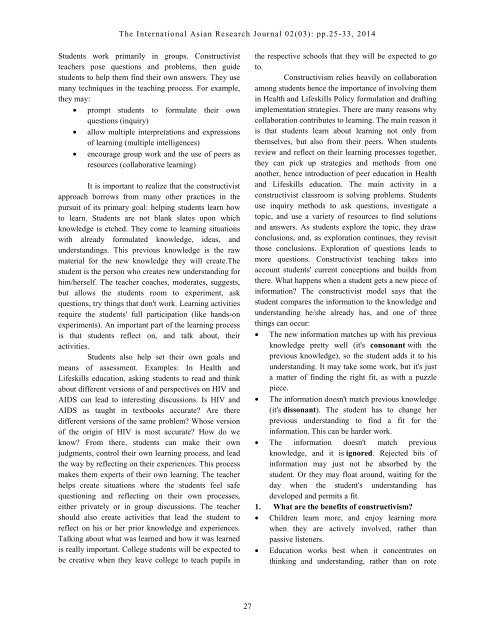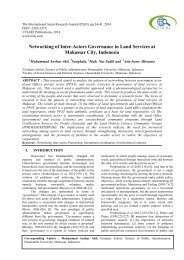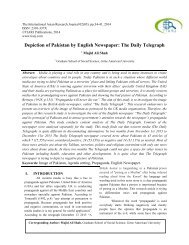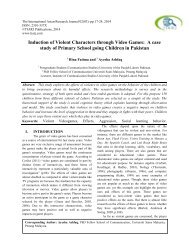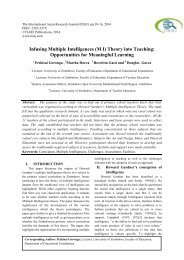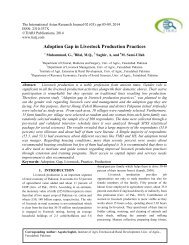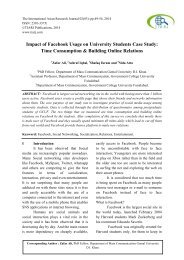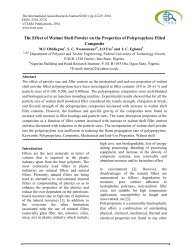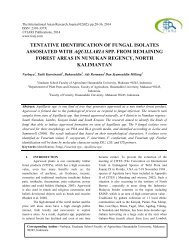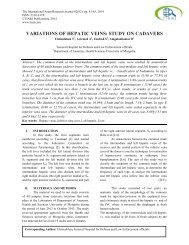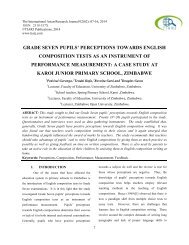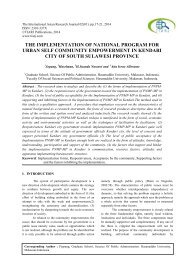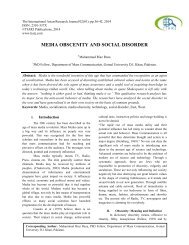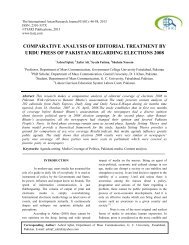Student Voices in the Implementation of Health and Lifeskills Policy in Zimbabwe Teacher Training Colleges. By: Priscilla Mujuru
You also want an ePaper? Increase the reach of your titles
YUMPU automatically turns print PDFs into web optimized ePapers that Google loves.
The International Asian Research Journal 02(03): pp.25-33, 2014<br />
<strong>Student</strong>s work primarily <strong>in</strong> groups. Constructivist<br />
teachers pose questions <strong>and</strong> problems, <strong>the</strong>n guide<br />
students to help <strong>the</strong>m f<strong>in</strong>d <strong>the</strong>ir own answers. They use<br />
many techniques <strong>in</strong> <strong>the</strong> teach<strong>in</strong>g process. For example,<br />
<strong>the</strong>y may:<br />
prompt students to formulate <strong>the</strong>ir own<br />
questions (<strong>in</strong>quiry)<br />
allow multiple <strong>in</strong>terpretations <strong>and</strong> expressions<br />
<strong>of</strong> learn<strong>in</strong>g (multiple <strong>in</strong>telligences)<br />
encourage group work <strong>and</strong> <strong>the</strong> use <strong>of</strong> peers as<br />
resources (collaborative learn<strong>in</strong>g)<br />
It is important to realize that <strong>the</strong> constructivist<br />
approach borrows from many o<strong>the</strong>r practices <strong>in</strong> <strong>the</strong><br />
pursuit <strong>of</strong> its primary goal: help<strong>in</strong>g students learn how<br />
to learn. <strong>Student</strong>s are not blank slates upon which<br />
knowledge is etched. They come to learn<strong>in</strong>g situations<br />
with already formulated knowledge, ideas, <strong>and</strong><br />
underst<strong>and</strong><strong>in</strong>gs. This previous knowledge is <strong>the</strong> raw<br />
material for <strong>the</strong> new knowledge <strong>the</strong>y will create.The<br />
student is <strong>the</strong> person who creates new underst<strong>and</strong><strong>in</strong>g for<br />
him/herself. The teacher coaches, moderates, suggests,<br />
but allows <strong>the</strong> students room to experiment, ask<br />
questions, try th<strong>in</strong>gs that don't work. Learn<strong>in</strong>g activities<br />
require <strong>the</strong> students' full participation (like h<strong>and</strong>s -on<br />
experiments). An important part <strong>of</strong> <strong>the</strong> learn<strong>in</strong>g process<br />
is that students reflect on, <strong>and</strong> talk about, <strong>the</strong>ir<br />
activities.<br />
<strong>Student</strong>s also help set <strong>the</strong>ir own goals <strong>and</strong><br />
means <strong>of</strong> assessment. Examples: In <strong>Health</strong> <strong>and</strong><br />
<strong>Lifeskills</strong> education, ask<strong>in</strong>g students to read <strong>and</strong> th<strong>in</strong>k<br />
about different versions <strong>of</strong> <strong>and</strong> perspectives on HIV <strong>and</strong><br />
AIDS can lead to <strong>in</strong>terest<strong>in</strong>g discussions. Is HIV <strong>and</strong><br />
AIDS as taught <strong>in</strong> textbooks accurate? Are <strong>the</strong>re<br />
different versions <strong>of</strong> <strong>the</strong> same problem? Whose version<br />
<strong>of</strong> <strong>the</strong> orig<strong>in</strong> <strong>of</strong> HIV is most accurate? How do we<br />
know? From <strong>the</strong>re, students can make <strong>the</strong>ir own<br />
judgments, control <strong>the</strong>ir own learn<strong>in</strong>g process, <strong>and</strong> lead<br />
<strong>the</strong> way by reflect<strong>in</strong>g on <strong>the</strong>ir experiences. This process<br />
makes <strong>the</strong>m experts <strong>of</strong> <strong>the</strong>ir own learn<strong>in</strong>g. The teacher<br />
helps create situations where <strong>the</strong> students feel safe<br />
question<strong>in</strong>g <strong>and</strong> reflect<strong>in</strong>g on <strong>the</strong>ir own processes,<br />
ei<strong>the</strong>r privately or <strong>in</strong> group discussions. The teacher<br />
should also create activities that lead <strong>the</strong> student to<br />
reflect on his or her prior knowledge <strong>and</strong> experiences.<br />
Talk<strong>in</strong>g about what was learned <strong>and</strong> how it was learned<br />
is really important. College students will be expected to<br />
be creative when <strong>the</strong>y leave college to teach pupils <strong>in</strong><br />
<strong>the</strong> respective schools that <strong>the</strong>y will be expected to go<br />
to.<br />
Constructivism relies heavily on collaboration<br />
among students hence <strong>the</strong> importance <strong>of</strong> <strong>in</strong>volv<strong>in</strong>g <strong>the</strong>m<br />
<strong>in</strong> <strong>Health</strong> <strong>and</strong> <strong>Lifeskills</strong> <strong>Policy</strong> formulation <strong>and</strong> draft<strong>in</strong>g<br />
implementation strategies. There are many reasons why<br />
collaboration contributes to learn<strong>in</strong>g. The ma<strong>in</strong> reason it<br />
is that students learn about learn<strong>in</strong>g not only from<br />
<strong>the</strong>mselves, but also from <strong>the</strong>ir peers. When students<br />
review <strong>and</strong> reflect on <strong>the</strong>ir learn<strong>in</strong>g processes toge<strong>the</strong>r,<br />
<strong>the</strong>y can pick up strategies <strong>and</strong> methods from one<br />
ano<strong>the</strong>r, hence <strong>in</strong>troduction <strong>of</strong> peer education <strong>in</strong> <strong>Health</strong><br />
<strong>and</strong> <strong>Lifeskills</strong> education. The ma<strong>in</strong> activity <strong>in</strong> a<br />
constructivist classroom is solv<strong>in</strong>g problems. <strong>Student</strong>s<br />
use <strong>in</strong>quiry methods to ask questions, <strong>in</strong>vestigate a<br />
topic, <strong>and</strong> use a variety <strong>of</strong> resources to f<strong>in</strong>d solutions<br />
<strong>and</strong> answers. As students explore <strong>the</strong> topic, <strong>the</strong>y draw<br />
conclusions, <strong>and</strong>, as exploration cont<strong>in</strong>ues, <strong>the</strong>y revisit<br />
those conclusions. Exploration <strong>of</strong> questions leads to<br />
more questions. Constructivist teach<strong>in</strong>g takes <strong>in</strong>to<br />
account students' current conceptions <strong>and</strong> builds from<br />
<strong>the</strong>re. What happens when a student gets a new piece <strong>of</strong><br />
<strong>in</strong>formation? The constructivist model says that <strong>the</strong><br />
student compares <strong>the</strong> <strong>in</strong>formation to <strong>the</strong> knowledge <strong>and</strong><br />
underst<strong>and</strong><strong>in</strong>g he/she already has, <strong>and</strong> one <strong>of</strong> three<br />
th<strong>in</strong>gs can occur:<br />
The new <strong>in</strong>formation matches up with his previous<br />
knowledge pretty well (it's consonant with <strong>the</strong><br />
previous knowledge), so <strong>the</strong> student adds it to his<br />
underst<strong>and</strong><strong>in</strong>g. It may take some work, but it's just<br />
a matter <strong>of</strong> f<strong>in</strong>d<strong>in</strong>g <strong>the</strong> right fit, as with a puzzle<br />
piece.<br />
The <strong>in</strong>formation doesn't match previous knowledge<br />
(it's dissonant). The student has to change her<br />
previous underst<strong>and</strong><strong>in</strong>g to f<strong>in</strong>d a fit for <strong>the</strong><br />
<strong>in</strong>formation. This can be harder work.<br />
The <strong>in</strong>formation doesn't match previous<br />
knowledge, <strong>and</strong> it is ignored. Rejected bits <strong>of</strong><br />
<strong>in</strong>formation may just not be absorbed by <strong>the</strong><br />
student. Or <strong>the</strong>y may float around, wait<strong>in</strong>g for <strong>the</strong><br />
day when <strong>the</strong> student's underst<strong>and</strong><strong>in</strong>g has<br />
developed <strong>and</strong> permits a fit.<br />
1. What are <strong>the</strong> benefits <strong>of</strong> constructivism?<br />
Children learn more, <strong>and</strong> enjoy learn<strong>in</strong>g more<br />
when <strong>the</strong>y are actively <strong>in</strong>volved, ra<strong>the</strong>r than<br />
passive listeners.<br />
Education works best when it concentrates on<br />
th<strong>in</strong>k<strong>in</strong>g <strong>and</strong> underst<strong>and</strong><strong>in</strong>g, ra<strong>the</strong>r than on rote<br />
27


